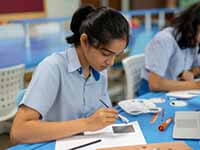Technology and the usage of technological devices are, for the most part, unavoidable in our current times. Even young children now have access to and make use of computers, tablets and smartphones to communicate with their families, as part of a play activity or in everyday life.
Screens and devices, as a result, have become very much a part of our children’s education, communication and entertainment needs. However, we know that too much screen time may harm children. For example, digital overuse could result in young children experiencing shorter attention spans, increased risk of obesity, decreased creativity and other such concerns.
As teachers and parents, the key question to address is not just how much time children are spending in front of a screen. According to an authority on this subject, the American Academy of Pediatrics says it’s more crucial to know, monitor and guide what children are engaging in during their screen time.
By teaching children digital literacy, parents and educators can help children maximise the positive benefits of technology while staying safe and not overusing their devices.
Digital Literacy: Why is it important?
Digital literacy is the ability to effectively navigate digital platforms and understand, evaluate, use and create content to communicate using a range of digital tools. Digital literacy is also sometimes called information literacy and includes internet safety.
By becoming digitally literate, our children learn to use technology safely, competently and responsibly.

Digitally literate students can:
1. Navigate the digital world smoothly. Since they have been taught right from wrong, they learn to exercise ethical decision-making skills while browsing and accessing resources online. Students can conduct research for class assignments, explore new technological developments and applications, and create their own content confidently.
2. Evaluate information and sources. As part of their digital awareness, students are taught to distinguish between reliable and unreliable sources of information. In higher grades, they are able to select high-quality and trusted websites to conduct their research and to identify bias in media, data and online resources.
3. Create content and communicate aptly. Children of all ages are now able to create their own content and express themselves through blogs, vlogs, podcasts, app-creation and more. Digital literacy enables students to understand the importance of attribution of others’ work, while they stay creative and do their own research for their original content.
4. Be digitally safe. While younger children need monitoring when using devices and online resources, all children are taught digital safety rules as part of a digital literacy programme. They know how to set strong passwords, protect their personal information, avoid contact with strangers online and to check with an adult before downloading anything they don’t already know about.
Also read: Digital safety and Well-being: 5 ways to navigate through the online world
Online risks and the longevity of digital footprints
With the amount of new online apps, multiple ways of accessing information and media sources, and the proliferation of false news, it is an on-going challenge for everyone, not just students, to stay aware of the constantly changing landscape and understand the risks involved (existing and new) in the online world.
It is therefore important for students to be guarded in how they use technology, to report incidents of bullying and be gracious in their online interactions, just as they are in real life.
Older students must realise that it is important to manage their digital footprint right from their student days, because the information that they put online or on social media platforms may live there forever. Recruiters are now accustomed to doing online background checks and while some platforms are purely for personal use, it is advisable to be careful about what we post and share online, for perhaps, eternity.
Digital Well-being and Information Literacy at GIIS
The teachers and staff at GIIS prioritise each child’s holistic well-being. As part of our commitment to prepare your child for the future, we implement and support digital literacy initiatives for students throughout their time at GIIS and talk to them about how they can promote their digital well-being.
We incorporate age-appropriate lessons on netiquette and proper online research techniques. Additionally, our counsellors share valuable tips on digital wellness during formal and informal sessions. We place educational posters across campus that feature vibrant illustrations and informative messages that remind children to be mindful of digital well-being.
Well-being captains support your children and are trained to identify unwelcome behaviour and report any concerns to teachers.
GIIS maintains a helpline for students in any sort of crisis. All students are welcome to access this resource. For GIIS Singapore, this number is +65 9723 4938.
Finally, we promote offline activities that support your child’s physical, emotional and mental health. Available activities include yoga, sports competitions, co-curricular activity clubs and classes like reading, dance and music, culinary arts, science clubs and many more.
If you’d like to know more about GIIS students’ technology usage and how we encourage digital well-being in our students, do reach out to us if you are able to visit us in person, we welcome you to book a campus tour for your family.

































